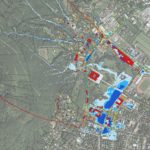Tool risk reduction measures
ORGANISE EMERGENCY RESPONSE
What do you find here?

This section is addressed to local and regional authorities, who are in charge of setting up emergency response plans to minimise risks caused by heavy rain events. Here you find a step-by-step manual that guides you through the process. To facilitate performing the single steps, you are asked to answer specific questions, carry out certain tasks, create certain documents and involve stakeholders. Provided templates and a catalogue of potential emergency measures support you in performing this work. An emergency response plan for heavy rain events will be the result of your efforts, consisting of, among others, legal responsibilities, a communication and alarm concept, an action plan and a map of emergency measures.
What is EMERGENCY RESPONSE and how can it contribute to risk reduction?
Emergency response plans support public authorities and organisations with security tasks in case of flooding. They are a strategic element in disaster management and help especially at the tactical level of operation management to support emergency services setting appropriate measures. Consequently, risk of life and the extent of damages can be minimised. Common practice and knowledge of key persons are made visible and accessible to all responsible.
Although the legal situation might differ between nations, this manual provides an overarching framework and is applicable for different countries, for heterogeneous administrative structures, for different geographical conditions and different hazard and risk information. Challenges in short-term weather forecasts as basis for setting emergency measures are addressed and ways are shown how to deal with this topic.
Get more in-depth knowledge on how to create an emergency response plan for heavy rain events following a 3-step approach:

General recommendations
Check the legal situation.
Who is in charge of creating emergency response plans? Which legal responsibilities are resulting from the existence of the plans?
Conduct regular trainings.
Knowing about responsibilities, the alarm concept and communication channels build the basis for fast reactions.
Ensure a well-organized crisis communication.
Due to short leading times, emergency measures need to be set up quickly.

Be aware of the data used in your hazard and risk maps.
Rainfall scenarios can only depict one part of the potential hazard situation. A real rainfall event might not match the scenarios depict.
Take into account different rainfall scenarios.
In case they are available, assess the differences regarding affected areas and possible emergency measures and consider them, when creating emergency response plans.
Evaluate existing emergency response plans.
Which parts contain helpful information? Where is a need to create interlinkages?

Step 1: Review the existing hazard analysis

Picture: Hydroconsult GmbH
Hazard maps for heavy rain events show the endangered areas of your region. As these maps will be the basis for developing adequate emergency measures, it is essential to take a closer look at them in order to
- be aware of the data quality of the hazard data
- know which areas are critically endangered
- know which heavy rain scenarios are critically endangering the region
- know where to obtain precipitation forecast data and of which quality
Learn more about hazard maps in general, or how to create a hazard map in tool ASSESSMENT and MAPPING.
Learn more about early warning systems in tool EARLY WARNING.
- What kind of precipitation/hydrological data was used creating the hazard map?
- What do you know about past scenarios?
- Which forecast data is available in your region?
- Where are the critical hazard points/areas in your region regarding run-off generation?
- What kind of hydraulic data was used creating the hazard map?
- Where are the cricital hazard points/areas in your region regarding flow paths?
- How sophisticated is the databasis of your hazard maps?
- Describe significant critical hazard points/areas.
- Analyse past heavy rainfall events and figure out which events may cause damage.
- Define all stakeholders that should be involved in this process.
- Host a stakeholder workshop to discuss the hazard analysis.
- Consider and record all results.
The guidance informs you in detail about all necessary steps with comprehensive background information and technical advices.
Download the toolkit section “General information & application assistance” [pdf; 1.35 MB] and the “Step 1: Manual” [pdf; 684 KB].
For performing the tasks various templates are available as download [zip; 3 MB]. They help you to carry out the tasks quicker and more efficient.

Step 2: Review the exisiting vulnerability analysis

Picture: tolmacho / Pixabay
Risk maps for heavy rain events show the combination of the hazard endangering an object or subject and its vulnerability. Vulnerability describes how a subject or object is prone to be harmed by heavy rain events. For example, children, elderly or handicapped people are vulnerable. The likelihood of a heavy rain event to happen is also considered in the risk. As these maps will be the basis for the development of adequate emergency measures, it is essential to analyse them in order to
- know the quality of the vulnerability data
- know the project region’s vulnerable objects
- have a prioritisation of the region’s critical infrastructure
- know the region’s critical risk points/areas
Learn more about risk maps in general in tool ASSESSMENT and MAPPING.
- What kind of data was used to locate exposed objects?
- What kind of data concerning the consequences of heavy rain events was used creating the risk map?
- Where are the critical points/areas with high damage potential?
- How sophisticated is the database of your vulnerability data?
- Is your focus area located in a rural, semi-urban or urban area?
- What resources are available to set actions during heavy rainfall events?
- Define where significant damage may occur.
- Mark points where emergency measures might be useful.
- Describe and prioritise the significant critical risk points/areas.
- Define all stakeholders that should be involved in this process.
- Host a stakeholder workshop to discuss the risk analysis.
- Consider and record all results.
The guidance informs you in detail about all necessary steps with comprehensive background information and technical advices.
The toolkit section “General information & application assistance” [pdf; 1.35 MB] and the “Step 2: Manual” [pdf; 708 KB] is available for download below.
For performing the tasks various templates are available as download [zip; 3 MB]. They help you to carry out the tasks quicker and more efficient.

Step 3: Define suitable measures

Picture: Rudolf Hornich/Land Steiermark
As floods caused by heavy rainfall tend to be events with a very short warning time, measures working during the event need to be accurately planned and well coordinated. It might be difficult to fulfil all prerequisite necessary to apply certain measures during heavy rainfall events. Hence, the measure concept should also include measures concerning mid or long term structural measures or information and awareness raising for citizens. An example catalogue of measures is provided.
By defining suitable measures an action plan will be elaborated, that will help the user to
- know how to minimise risks and damages
- know the responsibilities (legally and actively) for emergency measures
- know the available resources for setting up emergency measures
- know that higher authorities are aware of the measures
- know that all relevant stakeholders are informed about the measures
- know that local citizens are aware of the measures they are affected by and
- know who applies and adapts the measures
- Are there already emergency response plans available, concerning any kind of risk?
- Who is legally responsible for emergency measures?
- Who are the relevant players for emergency response planning and applying and adapting of emergency measures?
- What resources are available for emergency measures during extreme events?
- Evaluate what level of action plan is obtainable for you.
- Define responsibilities for every single measure.
- Develop a simple warning and alarm tool to assess the expected event intensity.
- Plan communication channels during an event.
- Define measures depending on available resources and reaction time. Focus particularly on your designated critical points/areas.
- Create an action plan (measures, emergency measures map).
- Fill out the final emergency response plan.
- Define all stakeholders that should be involved in this process.
- Host a meeting with key stakeholders to discuss available resources.
- Host a stakeholder workshop to discuss the planned emergency measures.
- Consider all results in the “Action Plan” and the “Emergency Response Plan”.
- Present the finalised action plan/emergency response plan to citizens
The guidance informs you in detail about all necessary steps with comprehensive background information and technical advices.
The toolkit section “General information & application assistance” and the “Step 3: Manual” is available for download below.
For performing the tasks various templates are available as download [zip; 3 MB]. They help you to carry out the tasks quicker and more efficient.
Download complete toolkit

Picture: falconp4 / Pixabay
You want to have all information in one download? Get here the complete toolkit comprising recommendations, manuals and templates.
EMERGENCY RESPONSE PLANNING FOR HEAVY RAIN RISKS | Available in German and English
RIOCOM Engineering Office for Environmental Engineering and Water Management
Office of the Styrian Government, Department 14 Water Management, Resources and Sustainability
Download [zip; 9 MB]
OUR STORIES
Emergency response plans for heavy rainfall events were set up for selected hot spots in the City of Graz

"On 16th April 2018, a major heavy rain event hit parts of the city centre causing flooding of underpasses, cellars, underground garages and a shopping centre. The event demonstrated that preparing of emergency response plans for pluvial flooding is a worthwhile endeavour for areas with a high risk. An emergency response toolkit was developed, which sets the framework for the necessary tasks and by stakeholder workshops decision makers were involved. The plan serves as an organisational tool for dealing with disasters caused by heavy rain events and as the basis for decision-making. Especially preventive measures are of great importance. If the affected people know about the possible dangers in advance and are informed in sufficient time, they can take measures independently. Finally, we were able to enhance the City of Graz’s preparedness for heavy rain events." (RIOCOM Ingenieurbüro für Kulturtechnik und Wasserwirtschaft)
Saxon municipalities Oderwitz and Leutersdorf tested and implemented the Austrian emergency response toolkit successfully

"Both rural communities have been affected by heavy rain and flood events several times in the past. The repair of the damage and sustainable reconstruction was realised, but both municipalities were aware that these efforts were not enough. By using a draft-version of the toolkit, the emergency response in the villages was improved in order to be able to react faster and more efficiently in the future. The work was carried out on site with great personal commitment and was supported by both mayors. The toolkit provided good orientation and step-by-step guidance so far. Even though this work is not yet completed, both communities feel already better prepared for future heavy rain events. We encourage further municipalities in Saxony and everywhere else to also develop heavy rain emergency response plans." (Anika Albrecht, Saxon State Office for Environment, Agriculture and Geology, Germany)
The Austrian emergency response toolkit enforces communication and provides orientation for action in Zagreb, Croatia

"Based on a draft-version of the Austrian toolkit for emergency response planning in Croatian langue, Croatian Waters triggered the identification of opportunities for improving the heavy rain emergency response system in Zagreb. Supported by the RAINMAN project experiences and tools it was analysed how the heavy rain emergency response system in Zagreb is working at present and findings from past experiences gained were derived. Further steps in the improvement of civil protection would have to be started by the responsible entities. The final version of the RAINMAN emergency response toolkit will support this greatly. A positive side effect of the RAINMAN activities was that the cooperation between Croatian Waters and responsible entities and institutions for emergency response in Croatia was strengthened, e.g. with the Public Fire Brigade of the City of Zagreb." (Alan Cibilić, Croatian Waters, Croatia)




